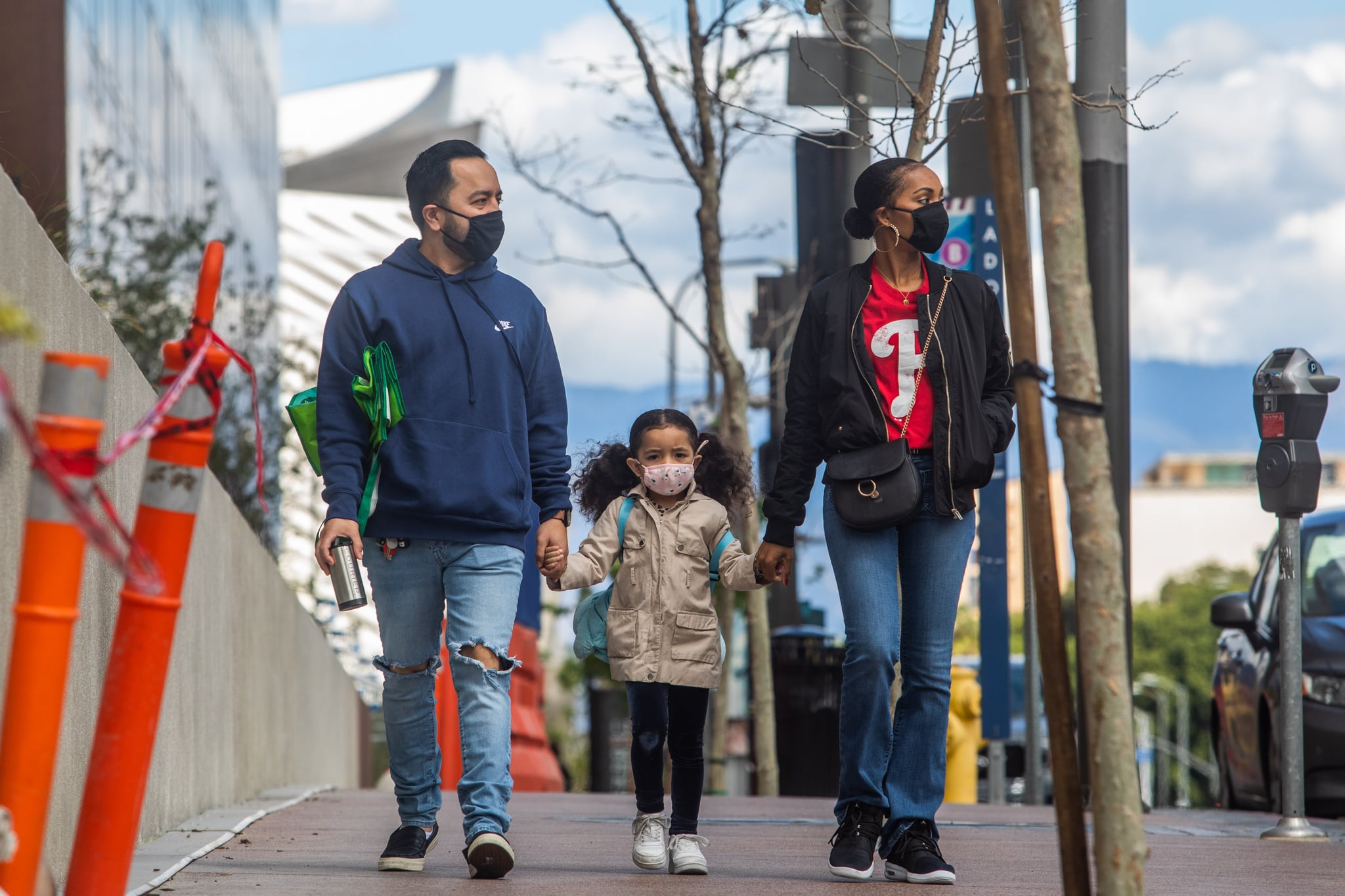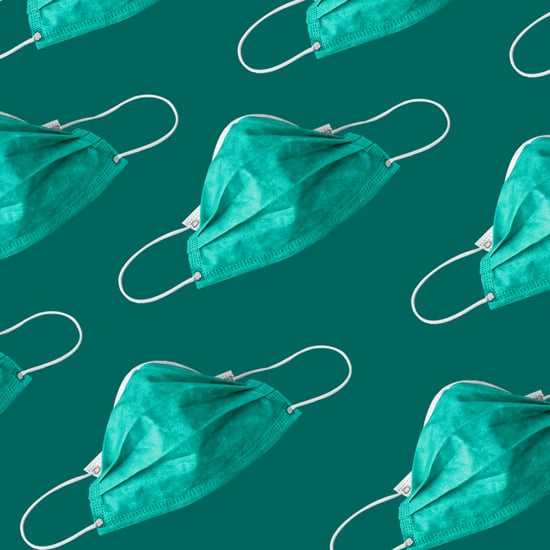What Parents Should Know About Face Masks on Kids
What Parents Need to Know About the New Face Mask Recommendation For Kids

Up until recently, Americans were expressly told not to wear masks – that the limited supply should be reserved for those who are sick and for healthcare workers. But late last week, that directive took a 180-degree shift. After more than a month of CDC recommendations advising against it, the government agency is now officially recommending universal masking in public. In other words, everyone should be wearing masks, everywhere.
The edict seemed swift and harsh. Taking the dog for a walk around the block? Wear a mask. Riding your scooter to the park? Wear a mask. Getting some fresh air on your front stoop? Wear a mask, all of you.
"Remember that something is better than nothing, and wearing it for a bit is better than not at all."
As a parent of two young kids, my immediate concern was for them. We've happened upon a few passersby in masks on our neighbourhood strolls, but would seeing nearly every stranger in a face-covering mask scare them? Would they be uncomfortable seeing me wrap one around my nose and mouth? And what about them? How would I even begin to convince them to wear a mask, when I've had years of proof that they can't be convinced to wear decidedly less obstructive accessories? They shed gloves in below-freezing temps and flick off sunglasses and baseball hats in the blaring heat. And try as I might during this time to quell their face-touching, I've still got a committed thumb-sucker and a rogue nose-picker on my family's roster. So, considering that we may be sheltering in place for months longer, how is any of this going to actually work?
I reached out to several experts to find out more about what these ever-evolving mask recommendations mean for our children.
Why Do We Need to Wear Masks Now?
Up until recently, the CDC cautioned against universal masking for fear of depleting the supply of masks for those most vulnerable. But now experts have weighed these concerns against the risk of further transmission, illness, healthcare resources, and fatalities, and have decided it is in our best interest to encourage healthy citizens to wear masks in public as well.
"There is widespread evidence, particularly from countries who have effectively curbed the COVID-19 pandemic like China, Japan, South Korea, and Taiwan, that universal masking can prevent community-based transmission," Dr. Chitra Akileswaran – the cofounder of Cleo, a resource for working parents – said, adding that because studies show that 25 percent of those carrying the coronavirus are asymptomatic, it can spread from those who are not yet feeling sick. In effect, seemingly healthy people may not be so. "It may be more contagious than we originally thought, so anything we can do to prevent the spread may be a worthwhile solution."
Can't Wearing a Mask Incorrectly Increase Our Risk of Getting COVID-19?
Some healthcare officials have warned – particularly before the new recommendations were released – that universal masking can actually increase an individual's risk of getting COVID-19.
"If you are not used to wearing a mask, you may be more likely to fiddle and fuss with it, which means touching your eyes, nose, mouth, and face more often – precisely the behaviours that spread infection," Akileswaran said.
However, data from countries where masking is a cultural norm – whether due to smog or congestion – shows that the benefits tend to outweigh the risks. Akileswaran also shared that although a 6-foot radius is typically sufficient to prevent exposure to those who are coughing and sneezing, new reenactments of sneezes demonstrate that droplet containing the virus could transmit as far as 27 feet. Wearing a mask can help prevent these far-travelling droplets from entering your airstream.
When Should We Be Wearing Masks?
The CDC has not released specific recommendations for masking children, except to denote that those younger than two years should not wear them under any circumstance due to potential breathing risks. For everyone else, they should be worn when in public for anything more than a short walk.
But for kids, specifically? Akileswaran believes there is room for nuance. "Children are at more risk of contaminating their masks due to touching them, moving them, and not having them on correctly," she said. "Given that children are overall at low risk for both acquiring and getting very sick from COVID-19, it may be OK to be more liberal about not masking children."
What that might mean for some families is that on a generally isolated walk around the neighbourhood, where few others are encountered, it's fine to leave masks at home. However, if you are taking your child on an essential errand, like to the grocery store – a strongly discouraged move if the child can be safely left at home – or to a doctor's appointment in which there may be a greater density of people, having them wear a mask is more prudent.
What Kind of Mask Should My Kid Wear?
When it comes to selecting a type of mask, options are obviously limited. Akileswaran anticipates the agency will promote the use of cloth masks – something made out of T-shirt material, a cotton bandana, or a towel that is able to be laundered and machine-dried without damage or change to its shape – for those at low or very low risk, which is the case for most young family members.
"They're appropriate for making a trip to the grocery store or doctor's office, for outdoor activities, and among children," she said.
According to Rebekah Wheeler, a registered nurse and certified midwife who is a lead adviser for Cleo, effective masks should meet the following parameters:
- Fits snugly but comfortably against the side of the face
- Is secured with ties or ear loops
- Includes multiple layers of fabric
- Allows for breathing without restriction
- Able to be removed by the child themselves
Akileswaran cautions against considering N95 respirators because they need to be carefully fitted to your face, and she recommends surgical masks for those with moderate risk or those who have COVID-19 symptoms and are trying to prevent the spread to others in their home.
How Do I Put a Mask on My Child?
When putting on and taking off your and your child's mask, it's important to follow a few basic steps:
- Wash your hands or clean with an alcohol-based hand sanitizer before handling your mask.
- Pick up the mask attachments – like the sides or strings – and cover your mouth and nose with the mask.
- Avoid touching the mask, especially over your nose or mouth, or use clean hands if you do.
- Remove the mask by grabbing the strings. Again, avoid touching the part that goes over your nose and mouth.
- Clean your hands once again.
But physically applying masks is only half the battle for most parents. How to get kids – particularly preschool-aged ones – to agree to wear them in the first place is a far more complicated task.
Thankfully, Wheeler said, the guidelines leave a "lot of room to personalize the mask and let your kid have a say in how it looks and what it's made of." She suggested involving your kid when buying one online or letting them choose a favourite old shirt or a fabric with their favourite characters to cut up and sew. Even decorating a mask by drawing pictures or colouring with fabric markers could get them more excited.
"Wear a mask yourself. Put them on together and talk about what you both see. Look in a mirror together. Take 'mask selfies.'"
She suggested parents have a deliberate conversation with their kids about why they might begin to see more masks, what the masks mean, and why they are important. From a social justice perspective, it's also worth explaining why some marginalized communities might not choose to wear them for fear of racial profiling.
"Wear a mask yourself," she said. "Put them on together and talk about what you both see. Look in a mirror together. Take 'mask selfies.'"
Additional options? "Put masks on stuffed animals or do video calls with older cousins and friends while they wear their masks," she said. Exposing kids to others who are wearing masks can help normalize the experience and promote good mask-wearing etiquette.
"It's a given that it will be tough to get kids to wear face masks," Wheeler said. "Remember that something is better than nothing, and wearing it for a bit is better than not at all."


